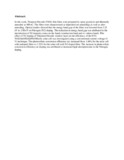Performance of TiO2/In(OH)iSj/Pb(OH)xSy Composite ETA Solar Cell Fabricated from Nitrogen Doped TiO2 Thin Film Window Layer
| dc.contributor.author | Ayieko, C O | |
| dc.contributor.author | Musembi, R J | |
| dc.contributor.author | Waita, S M | |
| dc.contributor.author | Aduda, B O | |
| dc.contributor.author | Jain, P K | |
| dc.date.accessioned | 2013-02-24T10:36:25Z | |
| dc.date.issued | 2012 | |
| dc.identifier.uri | http://erepository.uonbi.ac.ke:8080/xmlui/handle/123456789/10974 | |
| dc.description.abstract | In this work, Titanium Dioxide (TiO2) thin films were prepared by spray pyrolysis and thermally annealed at 400 oC. The films were characterized as deposited (no annealing) as well as after annealing. Optical studies showed that the energy band gap of the films was lowered from 3.25 eV to 2.90 eV on Nitrogen (N2) doping. The reduction in energy band gap was attributed to the introduction of N2 impurity states on the bands (conduction band and or valence band). The effect of N2 doping of Titanium Dioxide window layer on the efficiency of the ETA TiO2/In(OH)iSj/Pb(OH)xSy solar cell was investigated using a conventional current-voltage (I-V) technique. The photovoltaic conversion efficiency (η) increased from 1.06% for the solar cell with undoped films to 1.32% for the solar cell with N2-doped films. The increase in photovoltaic conversion efficiency on doping was attributed to increased light absorption due to the Nitrogen doping. | en |
| dc.language.iso | en | en |
| dc.subject | Titanium Dioxide | en |
| dc.subject | Conversion efficiency | en |
| dc.subject | Doping | en |
| dc.title | Performance of TiO2/In(OH)iSj/Pb(OH)xSy Composite ETA Solar Cell Fabricated from Nitrogen Doped TiO2 Thin Film Window Layer | en |
| dc.type | Article | en |
| local.publisher | School of Physical Sciences | en |

